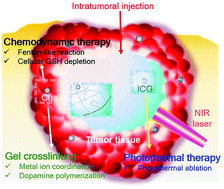Fenton-like reaction, glutathione reduction, and photothermal ablation-built-in hydrogels crosslinked by cupric sulfate for loco-regional cancer therapy†
Abstract
Fenton-like reaction-associated chemodynamic therapy (CDT) and hyperthermia-inducing photothermal therapy (PTT)-combined crosslinked hydrogel systems were developed for loco-regional cancer therapy. Cupric sulfate (Cu) has been employed to crosslink the catechol-functionalized hyaluronic acid (HC) polymer-based gel via metal–catechol coordination and covalent bonding of the catechol group (by pH adjustment). Cu can also be used as a hydroxyl radical-generating agent with endogenous H2O2 in cancer cells mediated by Fenton-like reaction and it can reduce intracellular glutathione (GSH) levels leading to the inhibition of reactive oxygen species (ROS) scavenging. These two strategies can amplify the ROS-initiated CDT efficiency for combating cancer. The Cu-incorporated crosslinked hydrogel structure with pH modulation was appropriate for injectable gel formation via a single syringe. The incorporation of indocyanine green (ICG) into the hydrogel network and near-infrared (NIR) laser irradiation provided a temperature elevation sufficient for induction of hyperthermia in cancer therapy. It is expected that the designed HC/Cu/ICG hydrogel can be used safely and efficiently for local CDT and PTT of breast cancer.



 Please wait while we load your content...
Please wait while we load your content...